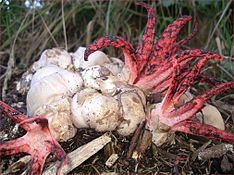Clathrus archeri
| Clathrus archeri | |
|---|---|
 |
|
| Octopus stinkhorn (Clathrus archeri) with suberumpent eggs | |
| Scientific classification | |
| Kingdom: | Fungi |
| Division: | Basidiomycota |
| Class: | Agaricomycetes |
| Order: | Phallales |
| Family: | Phallaceae |
| Genus: | Clathrus |
| Species: | C. archeri |
| Binomial name | |
|
Clathrus archeri (Berk.) Dring 1980 |
|
| Synonyms | |
| Clathrus archeri | |
|---|---|
| Mycological characteristics | |
| glebal hymenium | |
| no distinct cap | |
| hymenium attachment is irregular or not applicable | |
| lacks a stipe | |
| spore print is olive-brown | |
| ecology is saprotrophic | |
| edibility: inedible | |
Clathrus archeri (synonyms Lysurus archeri, Anthurus archeri, Pseudocolus archeri), commonly known as octopus stinkhorn, or devil's fingers, is a fungus indigenous to Australia and New Zealand, and an introduced species in Europe, North America and Asia. The young fungus erupts from a suberumpent egg by forming into four to seven elongated slender arms initially erect and attached at the top. The arms then unfold to reveal a pinkish-red interior covered with a dark-olive spore-containing gleba. In maturity it smells like putrid flesh. Recently, C. archeri var. alba with white tentacles or arms has been reported from the Shola Forests in the Western Ghats, Kerala, India.
Notes
Bibliography
...
Wikipedia
